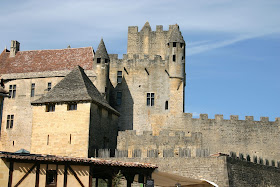The Hundred Years' War, as the name suggests, went on for an awfully long time. It was a war between France and England that lasted over a century (1337-1453), through the Black Death and the invention of gunpowder. The central issue was the crown of France, and it was entirely fought in France, where the results were grim for the population. France lost almost all the battles yet ultimately won the war, due to Joan of Arc.
The war is a sharp indication of the dangers of having hereditary rulers. When family and politics mix, the results can be deadly.
The problem went back to the twelfth century, when Eleanor of Aquitaine, duchess of Aquitaine (essentially the southwest quarter of France), divorced her husband, the king of France, and married King Henry II of England. For the next two centuries, through various incidents and adventures, the English crown held onto much of Aquitaine. The French were not pleased.
Then (1328) the last direct Capetian monarch, Charles IV, died without a son. The French crown was taken by his cousin Philip VI, the beginning of the so-called Valois line--Philip was a direct male-line descendant of Hugh Capet (d. 996), the first Capetian king, but his line went through a younger son. So far, so good--except that Charles had a sister who had married King Edward II of England. She thought her son, King Edward III, was the rightful king of France.
There were a few years of grumbling and threatening, and then in 1337 the French and English kings got into a big argument over Scotland (still a separate kingdom and an ally of France). King Philip declared that King Edward III had failed as a vassal and thus no longer could hold Aquitaine, and the war was on.
There are multi-volume modern accounts of all the ins and outs of the war. The English kept winning, including at one point capturing the French king and holding him for ransom. When the ransom wasn’t paid, he left England to go home and get the money together, promising to return if he couldn’t get it. He couldn’t get it. He returned to captivity in England. These guys believed in “honor.” The actual battles, however, were brutal. English bowmen and pikemen, and then the newly developed cannons devastated cavalry charges.
In 1420, there was an attempt to settle the war, basically by doing the same thing that had started it in the first place (maybe they were slow learners...). After winning the battle of Agincourt, still considered a great triumph of English warfare, King Henry V of England married a French princess, with the understanding that their future son would be king of both France and England. (Shakespeare wrote a play about this, that has been turned into several quite splendid movies. The play makes it sound as if all was set now. It wasn’t.)
The queen of England (French princess)’s brother, Charles VII, was declared illegitimate and set aside. This is where Joan of Arc enters the picture, having been told by angels to get Charles crowned as rightful king of France, which, although it seems startlingly unlikely, she actually did in 1429. The angels told her he really was legitimate, and he had perked right up when Joan gave him the news.
The English, in alliance with a number of great French nobles who had turned against Charles VII, captured Joan and had her burned at the stake as a heretic. In 1430, the boy king Henry VI of England was formally crowned king of France. But Joan had inspired the French, and a lot of the great French nobles switched sides back to Charles VII. It took another generation to make peace formally, but in spite of some ongoing battles it was clear that France had won.
When both Charles VII of France and Henry VI of England died in 1453, the war was officially over. Just in time for the English to start the War of the Roses.
The memory of the Hundred Years’ War still lingers in southwestern France (old Aquitaine), where much of the fighting took place. They’d barely gotten over the Albigensian Crusade when the war started. Many of the castles switched hands (French-English and back) multiple times, including Beynac, illustrated above. The area is peaceful, even dreamy now, but that’s a recent phenomenon.
© C. Dale Brittain 2018
For more about the war, Joan of Arc, Eleanor of Aquitaine, and so much more, see my new ebook, Positively Medieval: Life and Society in the Middle Ages.


No comments:
Post a Comment